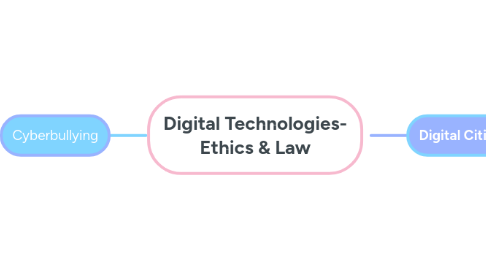
1. Cyberbullying
1.1. What?
1.1.1. When someone uses the internet to harass or intimidate someone
1.1.1.1. Misuse of power
1.1.1.2. Intentional
1.1.1.3. Ongoing
1.2. How
1.2.1. Social media
1.2.2. Games
1.2.3. Apps
1.2.4. Posts
1.2.4.1. Comments
1.2.5. Texts
1.2.5.1. Messages
1.2.5.1.1. Chats
1.2.6. Videos
1.2.6.1. Images
1.3. Used to:
1.3.1. Threaten
1.3.2. Intimidate
1.3.3. Humiliate
1.3.4. Harass
1.3.5. Insult
1.4. Initiatives
1.4.1. https://www.digitalcitizenship.nsw.edu.au/articles/how-to-respond-to-cyberbullying
1.4.2. https://www.esafety.gov.au/key-topics/cyberbullying
1.4.3. https://bullyingnoway.gov.au/
1.5. Efects of Cyberbullying
1.5.1. Low self-esteem
1.5.1.1. Shame
1.5.2. Anxiety
1.5.2.1. Stress
1.5.3. Emotional harm
1.5.3.1. Physical Harm
1.5.4. Depression
1.5.4.1. Suicide
1.5.5. Poor concentration
2. Digital Citizenship
2.1. What?
2.1.1. A person with the skills and knowledge to effectively use digital technology to participate in society and create and consume content
2.2. Safe, secure, quality access
2.3. Rights and responsbilities
2.4. Acceptable and respectful usage & acceptable behaviour
2.5. Privacy protection
2.6. Critical thinking
2.7. Approaches
2.7.1. E-safety
2.7.1.1. Privacy and security
2.7.2. Digital Literacy
2.7.2.1. Knowledge about how to apply digital technologies and resources
2.7.3. Meida Literacy
2.7.3.1. Use digital media in critically reflective and creative ways to communicate ideas
2.8. Students
2.8.1. Right to expect secure access
2.8.2. Virus protection, web filtering, safeguards
2.8.3. Access provided for research, learning and communication
2.9. Parents
2.9.1. Acknowledge the schools expectations for acceptable behaviour
2.10. Teachers
2.10.1. policy
2.10.2. School rules
2.10.3. Classroom expectations
